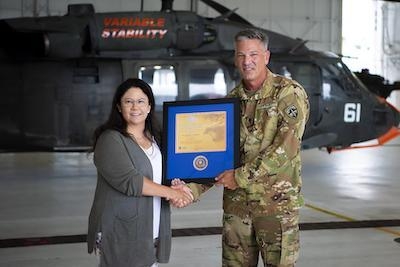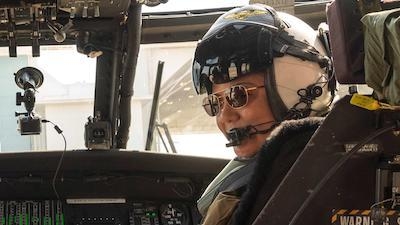Awarded To Aircrew Who Have Minimized Or Prevented Loss Of Life And Aircraft Through Outstanding Airmanship During Inflight Emergencies
U.S. Naval Test Pilot School rotary instructor Barb Gordon was the Navy’s first to receive the Army’s Broken Wing Award during a ceremony June 6 in Patuxent River.

Highly regarded and rarely awarded, the Army gives the Broken Wing to aircrew who have minimized or prevented loss of life and aircraft through outstanding airmanship during inflight emergencies. Gordon’s award marked the first time the Army presented the Broken Wing outside of the service.
Col. John Jones, commanding officer of the Army’s Redstone Test Center (RTC) in Redstone Arsenal, Alabama, presided over the ceremony and presented the award to Gordon (pictured in both images), a former naval lieutenant commander, who successfully recovered the UH-60L she was training a test pilot under instruction in October 5, 2016.
“Barb and Sylvia displayed that flight test can be done safely without negative outcome,” said Jones. “The Army appreciates your training, mentorship and expert airmanship.”
During the single-engine test technique with one engine at idle, the helicopter suffered failure on the opposite engine. Gordon had less than five seconds to recover the aircraft and experienced rates of descent between 9,000 and 12,000 feet per minute. According to the investigation, the mishap would have been catastrophic if not for the immediate actions by Gordon and then student Sylvia Grandstaff, now Chief Warrant Officer 3, who is a test pilot at RTC.
“After recovering the aircraft, the flight back to Pax was the longest seven minutes of my life,” said Gordon. “Sylvia and I were fully prepared to put the aircraft down anywhere – had we not followed the exact procedures we’d just briefed, we might have been picking pine needles from the bottom of the aircraft if we survived.”

Grandstaff also received a Broken Wing for her extraordinary skill during the incident at USNTPS. She attributes the aircrew’s survival to the nature of flight test rather than skill. Gordon and Grandstaff discussed the exact risk of engine failure and emergency procedure during both preflight and inflight briefings ahead of the test demonstration.
“It’s the culture of flight test that made the difference on the flight Barbara and I were on,” said Grandstaff. “Had it been just any other training flight, it might have gone differently.”
Both Gordon and the UH-60L continue to fly students during rotary technique training at USNTPS, the only domestic source of rotary test pilots and dedicated test pilot school of the Army. Today Gordon flies students a bit higher adding ample space between her aircraft and the ground. What is left of the mishap’s failed engine sits on Gordon’s desk and underlines the extreme level of risk – and importance – of the developmental test pilot, whose objective is to bring aircraft to the point of failure to ensure the safety and success of our service members on the flight line. The inherently risky discipline requires just that, plus extraordinary skill in the cockpit and aptitude as an engineer.
“When people ask if we changed how we do things after the mishap at USNTPS, the answer is no,” said Gordon. “We survived because test pilots plan for unique and unusual situations like the engine failure. That is what USNTPS gives students – without immediate critical thinking and risk management, things can get exponentially worse.”
The USNTPS trains more developmental test pilots, flight officers, engineers, industry and foreign partners in full spectrum test and evaluation of aircraft and aircraft systems than all domestic and international test schools combined. Located in Patuxent River, Maryland, the highly competitive school is forefront in development of modern test techniques and leads the industry in standardization of flight test. Its highly competitive program has graduated more than 90 NASA astronauts to date.
NAWCAD supports the research, development, engineering, test and evaluation of all Navy and Marine Corps air vehicle systems and trainers. It is the Navy’s largest warfare center with facilities in Patuxent River, Maryland; Lakehurst, New Jersey; and Orlando, Florida, the command delivers high quality, affordable products in support of military operating forces worldwide.
(Images provided with NAVAIR news release)
 Aero-News: Quote of the Day (12.09.25)
Aero-News: Quote of the Day (12.09.25) ANN's Daily Aero-Term (12.09.25): High Speed Taxiway
ANN's Daily Aero-Term (12.09.25): High Speed Taxiway ANN's Daily Aero-Linx (12.09.25)
ANN's Daily Aero-Linx (12.09.25) NTSB Final Report: Diamond Aircraft Ind Inc DA20C1 (A1); Robinson Helicopter R44
NTSB Final Report: Diamond Aircraft Ind Inc DA20C1 (A1); Robinson Helicopter R44 ANN FAQ: Q&A 101
ANN FAQ: Q&A 101




